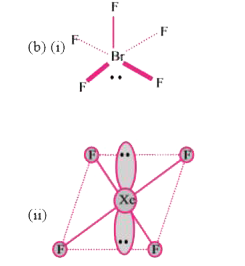InterviewSolution
Saved Bookmarks
| 1. |
(a) Account for the following: (i) Ozone is thermodynamically unstable. (ii) Solid PCl_(5) is ionic in nature. (iii) Fluorine forms only one oxoacid HOF. (b) Draw the structure of (i) BrF_(5) (ii) XeF_(4) (i) Compare the oxidizing action of F_(2) and Cl_(2) by considering parameters such as bond dissociation enthalpy, electron gain enthalpy and hydration enthalpy. (ii) Write the conditions to maximize the yield of H_(2)SO_(4) by contact process. (iii) Arrange the following in the increasing order of property mentioned : (a) H_(3)PO_(3), H_(3)PO_(4), H_(3)PO_(2) (Reducing character) (b) NH_(3), PH_(3)m AsH_(3), SbH_(3), BiH_(3) (Base strength) |
|
Answer» Solution :(a) (i) Endothermic compound/decomposition of ozone is exothermic is nature and `DeltaG` is negative/decomposition of ozone is spontaneous. (ii) Exists as `[PCl_(4)]^(+)[PCl_(6)]^(+)` (III) Shows only-1 oxidation state/most electronegative element/ absence of d-orbitals (B)(i)  Or (i) `F_(2)` is the STRONGER oxidising agent than chlorine (a) low enthalpy of dissociation of `F-F` bond (b) less negative electron gain enthalpy of F high hydration enthalpyof `F^(+)` ion (ii) Low temperature, high pressure and presence of catalyst (ii) `H_(3)PO_(4)lt H_(3)PO_(3) lt H_(3)PO_(2)` (iii) `BiH_(3) lt SbH_(3) lt AsH_(3) lt PH_(3) lt NH_(3)` |
|